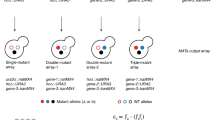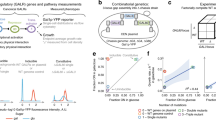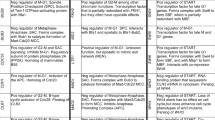Abstract
Large-scale genetic interaction studies provide the basis for defining gene function and pathway architecture. Recent advances in the ability to generate double mutants en masse in Saccharomyces cerevisiae have dramatically accelerated the acquisition of genetic interaction information and the biological inferences that follow. Here we describe a method based on F factor–driven conjugation, which allows for high-throughput generation of double mutants in Escherichia coli. This method, termed genetic interaction analysis technology for E. coli (GIANT-coli), permits us to systematically generate and array double-mutant cells on solid media in high-density arrays. We show that colony size provides a robust and quantitative output of cellular fitness and that GIANT-coli can recapitulate known synthetic interactions and identify previously unidentified negative (synthetic sickness or lethality) and positive (suppressive or epistatic) relationships. Finally, we describe a complementary strategy for genome-wide suppressor-mutant identification. Together, these methods permit rapid, large-scale genetic interaction studies in E. coli.
This is a preview of subscription content, access via your institution
Access options
Subscribe to this journal
Receive 12 print issues and online access
$259.00 per year
only $21.58 per issue
Buy this article
- Purchase on Springer Link
- Instant access to full article PDF
Prices may be subject to local taxes which are calculated during checkout




Similar content being viewed by others
References
Boone, C., Bussey, H. & Andrews, B.J. Exploring genetic interactions and networks with yeast. Nat. Rev. Genet. 8, 437–449 (2007).
Tong, A.H. et al. Systematic genetic analysis with ordered arrays of yeast deletion mutants. Science 294, 2364–2368 (2001).
Tong, A.H. et al. Global mapping of the yeast genetic interaction network. Science 303, 808–813 (2004).
Pan, X. et al. A robust toolkit for functional profiling of the yeast genome. Mol. Cell 16, 487–496 (2004).
Collins, S.R. et al. Functional dissection of protein complexes involved in yeast chromosome biology using a genetic interaction map. Nature 466, 806–810 (2007).
Schuldiner, M. et al. Exploration of the function and organization of the yeast early secretory pathway through an epistatic miniarray profile. Cell 123, 507–519 (2005).
Roguev, A., Wiren, M., Weissman, J.S. & Krogan, N.J. High-throughput genetic interaction mapping in the fission yeast Schizosaccharomyces pombe. Nat. Methods 4, 861–866 (2007).
Byrne, A.B. et al. A global analysis of genetic interactions in Caenorhabditis elegans. J. Biol. 6, 8 (2007).
Breitkreutz, B.J. et al. The BioGRID Interaction Database: 2008 update. Nucleic Acids Res. 36, D637–D640 (2008).
Ara, K. et al. Bacillus minimum genome factory—effective utilization of microbial genome information. Biotechnol. Appl. Biochem 46, 1169–1178 (2006).
Ito, M., Baba, T. & Mori, H. Functional analysis of 1440 Escherichia coli genes using the combination of knock-out library and phenotype microarrays. Metab. Eng. 7, 318–327 (2005).
Low, K.B. Hfr strains of Escherichia coli K-12. In Escherichia coli and Salmonella: Cellular and Molecular Biology Vol. 2 (ed. Neidhardt, F.C. et al.) 2402–2405 (ASM Press, Washington, DC, 1996).
Francois, V., Conter, A. & Louarn, J.M. Properties of new Escherichia coli Hfr strains constructed by integration of pSC101-derived conjugative plasmids. J. Bacteriol. 172, 1436–1440 (1990).
Bachmann, B.J. Derivations and genotypes of some mutant derivatives of Escherichia Coli K-12. In Escherichia coli and Salmonella: Cellular and Molecular Biology Vol. 2 (ed. Neidhardt, F.C. et al.) 2460–2488 (ASM Press, Washington, DC, 1996).
Baba, T. et al. Construction of Escherichia coli K-12 in-frame, single-gene knockout mutants: the Keio collection. Mol. Syst. Biol. 2, 0008 (2006).
Nielsen, H.J., Youngren, B., Hansen, F.G. & Austin, S. Dynamics of Escherichia coli chromosome segregation during multifork replication. J. Bacteriol. 189, 8660–8666 (2007).
Nielsen, H.J., Li, Y., Youngren, B., Hansen, F.G. & Austin, S. Progressive segregation of the Escherichia coli chromosome. Mol. Microbiol. 61, 383–393 (2006).
Collins, S.R., Schuldiner, M., Krogan, N.J. & Weissman, J.S. A strategy for extracting and analyzing large-scale quantitative epistatic interaction data. Genome Biol. 7, R63 (2006).
Hoekstra, W.P. & Havekes, A.M. On the role of the recipient cell during conjugation in Escherichia coli. Antonie Van Leeuwenhoek 45, 13–18 (1979).
Rizzitello, A.E., Harper, J.R. & Silhavy, T.J. Genetic evidence for parallel pathways of chaperone activity in the periplasm of Escherichia coli. J. Bacteriol. 183, 6794–6800 (2001).
Charlson, E.S., Werner, J.N. & Misra, R. Differential effects of yfgL mutation on Escherichia coli outer membrane proteins and lipopolysaccharide. J. Bacteriol. 188, 7186–7194 (2006).
Onufryk, C., Crouch, M.L., Fang, F.C. & Gross, C.A. Characterization of six lipoproteins in the σE regulon. J. Bacteriol. 187, 4552–4561 (2005).
Rouviere, P.E. & Gross, C.A. SurA, a periplasmic protein with peptidyl-prolyl isomerase activity, participates in the assembly of outer membrane porins. Genes Dev. 10, 3170–3182 (1996).
Sklar, J.G., Wu, T., Kahne, D. & Silhavy, T.J. Defining the roles of the periplasmic chaperones SurA, Skp, and DegP in Escherichia coli. Genes Dev. 21, 2473–2484 (2007).
Danese, P.N., Snyder, W.B., Cosma, C.L., Davis, L.J. & Silhavy, T.J. The Cpx two-component signal transduction pathway of Escherichia coli regulates transcription of the gene specifying the stress-inducible periplasmic protease, DegP. Genes Dev. 9, 387–398 (1995).
Pogliano, J., Lynch, A.S., Belin, D., Lin, E.C. & Beckwith, J. Regulation of Escherichia coli cell envelope proteins involved in protein folding and degradation by the Cpx two-component system. Genes Dev. 11, 1169–1182 (1997).
Bardwell, J.C., McGovern, K. & Beckwith, J. Identification of a protein required for disulfide bond formation in vivo. Cell 67, 581–589 (1991).
Leichert, L.I. & Jakob, U. Protein thiol modifications visualized in vivo. PLoS Biol. 2, e333 (2004).
Qu, J., Mayer, C., Behrens, S., Holst, O. & Kleinschmidt, J.H. The trimeric periplasmic chaperone Skp of Escherichia coli forms 1:1 complexes with outer membrane proteins via hydrophobic and electrostatic interactions. J. Mol. Biol. 374, 91–105 (2007).
Parsons, L.M., Lin, F. & Orban, J. Peptidoglycan recognition by Pal, an outer membrane lipoprotein. Biochemistry 45, 2122–2128 (2006).
Cascales, E. & Lloubes, R. Deletion analyses of the peptidoglycan-associated lipoprotein Pal reveals three independent binding sequences including a TolA box. Mol. Microbiol. 51, 873–885 (2004).
Cascales, E., Lloubes, R. & Sturgis, J.N. The TolQ-TolR proteins energize TolA and share homologies with the flagellar motor proteins MotA-MotB. Mol. Microbiol. 42, 795–807 (2001).
Gerding, M.A., Ogata, Y., Pecora, N.D., Niki, H. & de Boer, P.A. The trans-envelope Tol-Pal complex is part of the cell division machinery and required for proper outer-membrane invagination during cell constriction in E. coli. Mol. Microbiol. 63, 1008–1025 (2007).
Inoue, T. et al. Genome-wide screening of genes required for swarming motility in Escherichia coli K-12. J. Bacteriol. 189, 950–957 (2007).
Bochner, B.R. New technologies to assess genotype-phenotype relationships. Nat. Rev. Genet. 4, 309–314 (2003).
Butland, G. et al. Interaction network containing conserved and essential protein complexes in Escherichia coli. Nature 433, 531–537 (2005).
Chen, C.S. et al. A proteome chip approach reveals new DNA damage recognition activities in Escherichia coli. Nat. Methods 5, 69–74 (2008).
Mazurkiewicz, P., Tang, C.M., Boone, C. & Holden, D.W. Signature-tagged mutagenesis: barcoding mutants for genome-wide screens. Nat. Rev. Genet. 7, 929–939 (2006).
Girgis, H.S., Liu, Y., Ryu, W.S. & Tavazoie, S. A comprehensive genetic characterization of bacterial motility. PLoS Genet. 3, 1644–1660 (2007).
Acknowledgements
We thank S. Lee, A. Wong and J. Lee for technical assistance, and C.J. Ingles, P.J. Kiley, C. Squires, S.A. Johnson, A. Hochschild & T.J. Silhavy for critically reading this manuscript and offering useful suggestions. This work was supported by Sandler Family Funding (to C.A.G. and to N.J.K.), US National Institutes of Health (GM036278 to C.A.G. and GM62662 to B.L.W.), Japanese Ministry of Education, Culture, Sports, Science and Technology (Core Research for Evolutional Science and Technology) Grant-in-Aid for Scientific Research and Grant-in-Aid for Scientific Research on Priority Areas (to H.M.). A.T. is a recipient of a European Molecular Biology Organization fellowship.
Author information
Authors and Affiliations
Contributions
A.T., R.J.N., D.A.S., J.S.W., N.J.K. and C.A.G. designed research; A.T., R.J.N., D.A.S. and B.L. executed research; A.T., R.J.N., M.S., S.C. and H.B. analyzed data; N.Y., R.T., B.L.W. and H.M. contributed new reagents (single-gene knockout libraries and CIP plasmids); A.T., N.J.K. and C.A.G. wrote the paper; R.J.N., M.S., B.L.W. and J.S.W. edited the paper.
Corresponding authors
Supplementary information
Supplementary Text and Figures
Supplementary Methods, Supplementary Figures 1–5, Supplementary Tables 1–3 (PDF 1706 kb)
Rights and permissions
About this article
Cite this article
Typas, A., Nichols, R., Siegele, D. et al. High-throughput, quantitative analyses of genetic interactions in E. coli. Nat Methods 5, 781–787 (2008). https://doi.org/10.1038/nmeth.1240
Received:
Accepted:
Published:
Issue Date:
DOI: https://doi.org/10.1038/nmeth.1240
This article is cited by
-
Improved prediction of bacterial CRISPRi guide efficiency from depletion screens through mixed-effect machine learning and data integration
Genome Biology (2024)
-
Large-scale data analysis for robotic yeast one-hybrid platforms and multi-disciplinary studies using GateMultiplex
BMC Biology (2021)
-
Genetic landscape of T cells identifies synthetic lethality for T-ALL
Communications Biology (2021)
-
Transposon insertion site sequencing (TIS) of Pseudomonas aeruginosa
Journal of Microbiology (2021)
-
CSN: unsupervised approach for inferring biological networks based on the genome alone
BMC Bioinformatics (2020)



